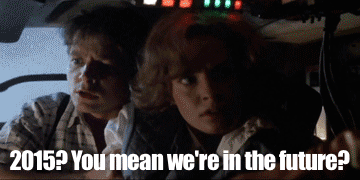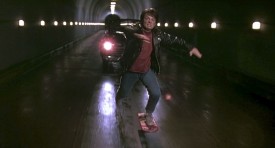 We’ve finally caught up with Doc Brown and his flying DeLorean, and arrived in 2015. (Alright, technically we haven’t caught up with him until October 21st, but go with me here.) Inevitably this has led to a number of articles comparing the 2015 of Back to the Future Part II with the reality of today’s world. While this is fun, it misses the point.
We’ve finally caught up with Doc Brown and his flying DeLorean, and arrived in 2015. (Alright, technically we haven’t caught up with him until October 21st, but go with me here.) Inevitably this has led to a number of articles comparing the 2015 of Back to the Future Part II with the reality of today’s world. While this is fun, it misses the point.
It’s not the job of sci-fi filmmakers to predict the future, just as it’s not the job of period filmmakers to present the past with slavish accuracy. It’s the filmmaker’s job to present an environment that is believable within the context of the story, and, crucially, that is thematically appropriate for the story.

The Back to the Future films are comedies first and foremost, so they made the future fun. Writer-producer Bob Gale realised that he would fail if he genuinely tried to predict the future. “We decided that the only way to deal with it was to make it optimistic, and have a good time with it,” he says in the official behind-the-scenes book of the trilogy.
Production designer Rick Carter notes how the optimistic 2015 mirrors the rose-tinted 1955 portrayed in the first film. “In Part I the 1955 square had a beautiful, grassy park. In the ’80s it was paved over for a parking lot, and in 2015, once again, we have this serene park and pond – with 75 shops underneath.”

Flying cars and hoverboards don’t exist in the real 2015, but if they hadn’t in BTTF’s fictional 2015 then we would have been denied the brilliant tunnel sequence at the climax of Part II. (“Manure, I hate manure.”) It was important to the story that the future was different from 1985, that skateboards and cars had leapt forward so that sequences from Part I could be revisited with a futuristic twist, rather than simply being repeated with ground-based skateboards and cars.

“We just modified ordinary, everyday conveniences,” Gale continues. Kids watched too much TV in the ’80s, so he envisaged a future in which this was taken to a ridiculous extreme, with kids wearing their TVs as glasses. Microwave meals had begun to compete with home cooking, so Gale invented another leap forward with the pizza-inflating food hydrator. As is inevitable and right, yesterday’s vision of tomorrow tells us more about yesterday than tomorrow.
In the end, it’s not 2015 that looks ridiculous to the modern BTTF viewer, it’s the ’80s. 1985 is portrayed bleakly throughout the trilogy, with its rundown Hill Valley square, its Libyan terrorists, its graffitied high school, the materialistic fawning over shiny black Toyotas, and the decadence and corruption of the “Biff-horrific” 1985 seen in Part II. Explaining why he built the time machine, Doc Brown soliloquizes: “The intent here is to gain a clear perception of humanity, where we’ve been, where we’re going, the pitfalls, the possibilities, the perils and the promise.” The filmmakers clearly believed that the ’80s were a pitfall, but the future had promise. And that optimism is still as appealing today as it was in 1989.
Plus flying DeLoreans are cool.
